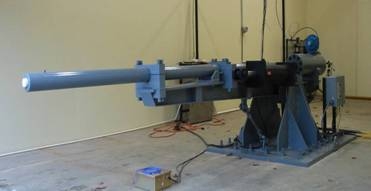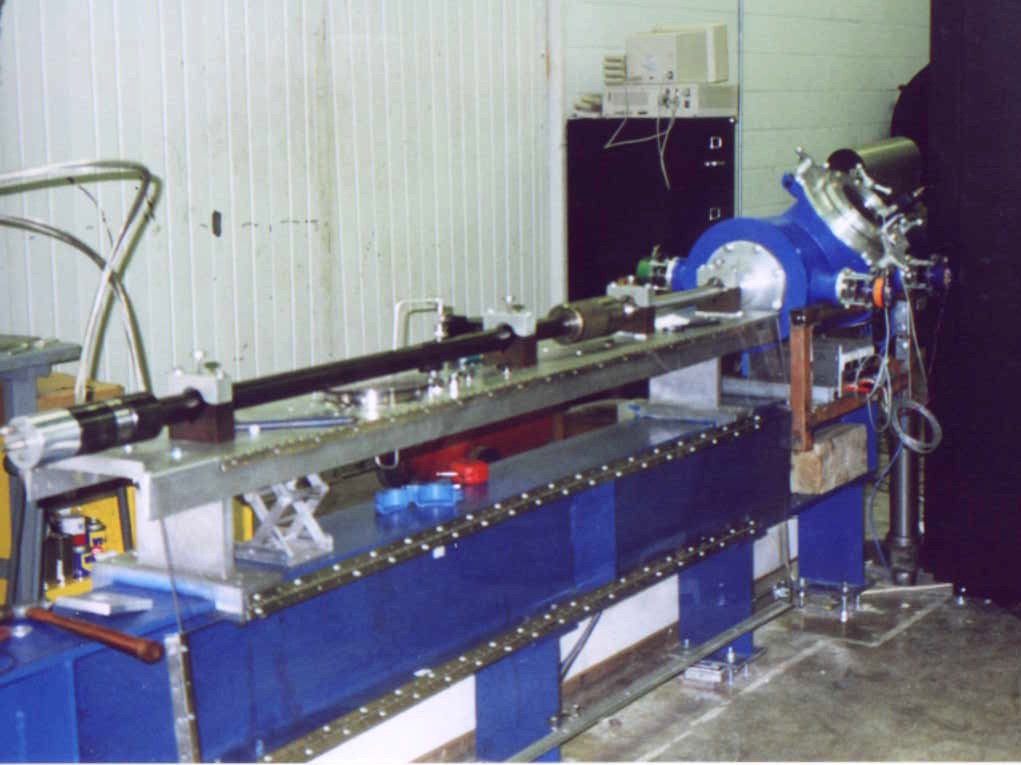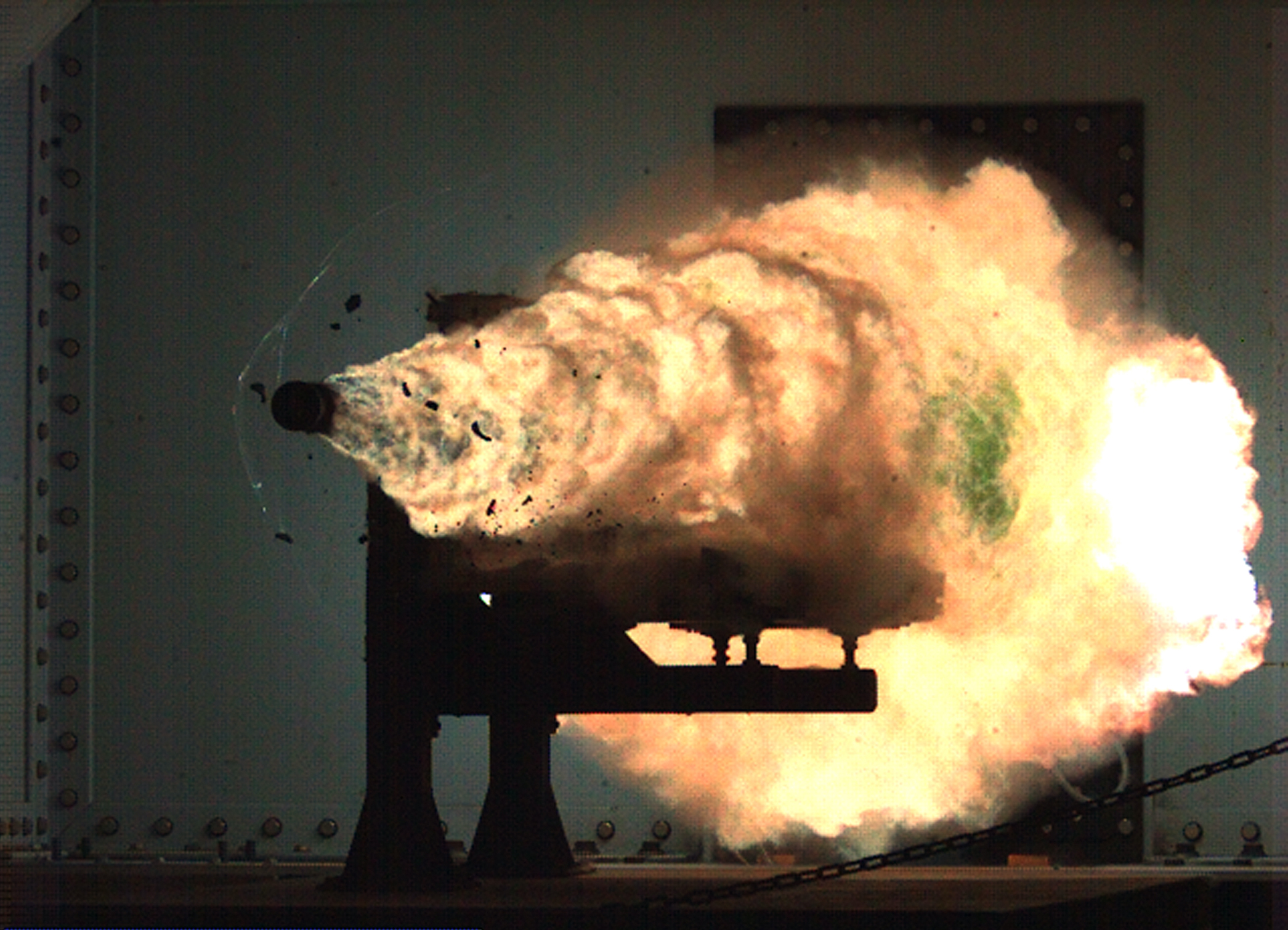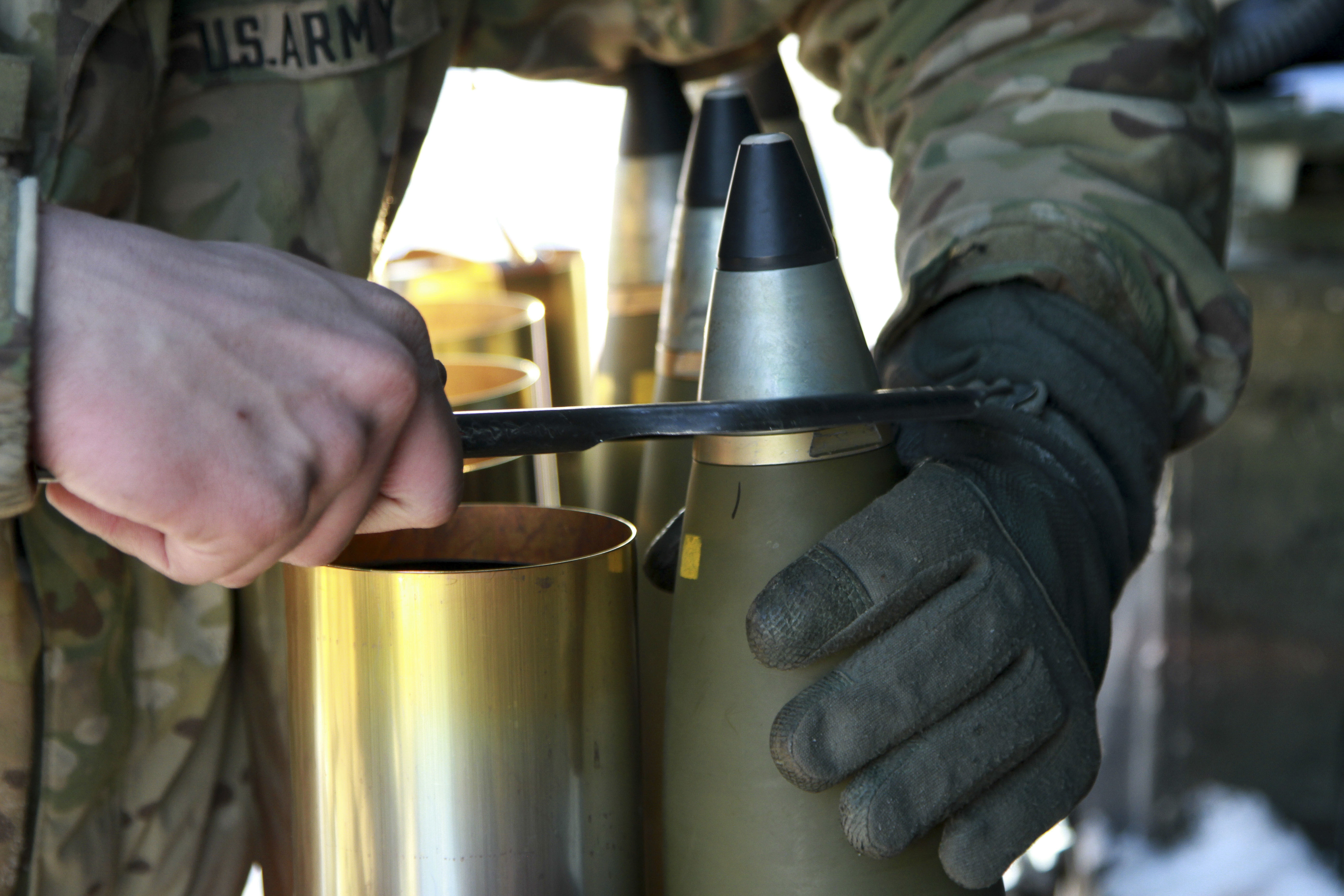|
Combustion Light-gas Gun
A combustion light-gas gun (CLGG) is a projectile weapon that utilizes the explosive force of low molecular-weight combustible gases, such as hydrogen mixed with oxygen, as propellant. When the gases are ignited, they burn, expand and propel the projectile out of the barrel with higher efficiency relative to solid propellant and have achieved higher muzzle velocities in experiments. Combustion light-gas gun technology is one of the areas being explored in an attempt to achieve higher velocities from artillery to gain greater range. Conventional guns use solid propellants, usually nitrocellulose-based compounds, to develop the chamber pressures needed to accelerate the projectiles. CLGGs' gaseous propellants are able to increase the propellant's specific impulse. Therefore, hydrogen is typically the first choice; however, other propellants like methane can be used. While this technology does appear to provide higher velocities, the main drawback with gaseous or liquid propell ... [...More Info...] [...Related Items...] OR: [Wikipedia] [Google] [Baidu] |
Methane
Methane ( , ) is a chemical compound with the chemical formula (one carbon atom bonded to four hydrogen atoms). It is a group-14 hydride, the simplest alkane, and the main constituent of natural gas. The relative abundance of methane on Earth makes it an economically attractive fuel, although capturing and storing it poses technical challenges due to its gaseous state under normal conditions for temperature and pressure. Naturally occurring methane is found both below ground and under the seafloor and is formed by both geological and biological processes. The largest reservoir of methane is under the seafloor in the form of methane clathrates. When methane reaches the surface and the atmosphere, it is known as atmospheric methane. The Earth's atmospheric methane concentration has increased by about 150% since 1750, and it accounts for 20% of the total radiative forcing from all of the long-lived and globally mixed greenhouse gases. It has also been detected on other ... [...More Info...] [...Related Items...] OR: [Wikipedia] [Google] [Baidu] |
Artillery By Type
Artillery is a class of heavy military ranged weapons that launch munitions far beyond the range and power of infantry firearms. Early artillery development focused on the ability to breach defensive walls and fortifications during sieges, and led to heavy, fairly immobile siege engines. As technology improved, lighter, more mobile field artillery cannons developed for battlefield use. This development continues today; modern self-propelled artillery vehicles are highly mobile weapons of great versatility generally providing the largest share of an army's total firepower. Originally, the word "artillery" referred to any group of soldiers primarily armed with some form of manufactured weapon or armor. Since the introduction of gunpowder and cannon, "artillery" has largely meant cannons, and in contemporary usage, usually refers to shell-firing guns, howitzers, and mortars (collectively called ''barrel artillery'', ''cannon artillery'', ''gun artillery'', or - a layman term ... [...More Info...] [...Related Items...] OR: [Wikipedia] [Google] [Baidu] |
Scram Cannon
A ram accelerator is a device for accelerating projectiles or just a single projectile to extremely high speeds using jet-engine-like propulsion cycles based on ramjet or scramjet combustion processes. It is thought to be possible to achieve non-rocket spacelaunch with this technology. It consists of a long tube (barrel) filled with a mixture of combustible gases with a frangible diaphragm at either end to contain the gases. The projectile is fired by another means (e.g., a light-gas gun or railgun) supersonically through the first diaphragm into the tube. Then the projectile burns the gases as fuel, because it is shaped like a ramjet or scramjet core, and accelerates under jet propulsion. Other physics come into play at higher velocities. Description In a normal ramjet, air is compressed between a spike-shaped centerbody and an outer cowling, fuel is added and burned, and high speed exhaust gases are expanded supersonically out of the nozzle to generate thrust. In a ram accele ... [...More Info...] [...Related Items...] OR: [Wikipedia] [Google] [Baidu] |
Light-gas Gun
The light-gas gun is an apparatus for physics experiments. It is a highly specialized gun designed to generate extremely high velocities. It is usually used to study high-speed impact phenomena (hypervelocity research), such as the formation of impact craters by meteorites or the erosion of materials by micrometeoroids. Some basic material research relies on projectile impact to create high pressure; such systems are capable of forcing liquid hydrogen into a metallic state. Operation A light-gas gun works on the same principle as a spring piston airgun. A large-diameter piston is used to force a gaseous working fluid through a smaller-diameter barrel containing the projectile to be accelerated. This reduction in diameter acts as a lever, increasing the speed while decreasing the pressure. In an airgun, the large piston is powered by a spring or compressed air, and the working fluid is atmospheric air. In a light-gas gun, the piston is powered by a chemical reaction (usually g ... [...More Info...] [...Related Items...] OR: [Wikipedia] [Google] [Baidu] |
Railgun
A railgun or rail gun is a linear motor device, typically designed as a weapon, that uses electromagnetic force to launch high velocity projectiles. The projectile normally does not contain explosives, instead relying on the projectile's high speed, mass, and kinetic energy to inflict damage. The railgun uses a pair of parallel conductors (rails), along which a sliding armature is accelerated by the electromagnetic effects of a current that flows down one rail, into the armature and then back along the other rail. It is based on principles similar to those of the homopolar motor. As of 2020, railguns have been researched as weapons utilizing electromagnetic forces to impart a very high kinetic energy to a projectile (e.g. APFSDS) rather than using conventional propellants. While explosive-powered military guns cannot readily achieve a muzzle velocity of more than ≈, railguns can readily exceed . For a similar projectile, the range of railguns may exceed that of conventional ... [...More Info...] [...Related Items...] OR: [Wikipedia] [Google] [Baidu] |
Zumwalt-class Destroyer
The ''Zumwalt''-class destroyer is a class of three United States Navy guided-missile destroyers designed as multi-mission stealth ships with a focus on land attack. It is a multi-role class that was designed with a primary role of naval gunfire support and secondary roles of surface warfare and anti-aircraft warfare. The class design emerged from the DD-21 "land attack destroyer" program as "DD(X)" and was intended to take the role of battleships in meeting a congressional mandate for naval fire support. The ship is designed around its two Advanced Gun Systems (AGS), turrets with 920 round magazines, and unique Long Range Land Attack Projectile (LRLAP) ammunition. LRLAP procurement was canceled, rendering the guns unusable, so the Navy re-purposed the ships for surface warfare. Starting in 2023, the Navy will remove the AGS from the ships and replace them with hypersonic missiles. These ships are classed as destroyers, but they are much larger than any other active destroyers or ... [...More Info...] [...Related Items...] OR: [Wikipedia] [Google] [Baidu] |
Artillery Fuze
An artillery fuze or fuse is the type of munition fuze used with artillery munitions, typically projectiles fired by guns (field, anti-aircraft, coast and naval), howitzers and mortars. A fuze is a device that initiates an explosive function in a munition, most commonly causing it to detonate or release its contents, when its activation conditions are met. This action typically occurs a preset time after firing ( time fuze), or on physical contact with ( contact fuze) or detected proximity to the ground, a structure or other target (proximity fuze). Fuze, a variant of fuse, is the official NATO spelling. Terminology Munitions fuzes are also used with rockets, aircraft bombs, guided missiles, grenades and mines, and some direct fire cannon munitions (small calibre and tank guns). Broadly, fuzes function on impact (percussion fuzes) or at a pre-determined time period after firing (time fuzes). However, by the 18th century time fuzes were aimed to function in the air and in the ... [...More Info...] [...Related Items...] OR: [Wikipedia] [Google] [Baidu] |
Specific Impulse
Specific impulse (usually abbreviated ) is a measure of how efficiently a reaction mass engine (a rocket using propellant or a jet engine using fuel) creates thrust. For engines whose reaction mass is only the fuel they carry, specific impulse is exactly proportional to the effective exhaust gas velocity. A propulsion system with a higher specific impulse uses the mass of the propellant more efficiently. In the case of a rocket, this means less propellant needed for a given delta-v, so that the vehicle attached to the engine can more efficiently gain altitude and velocity. In an atmospheric context, specific impulse can include the contribution to impulse provided by the mass of external air that is accelerated by the engine in some way, such as by an internal turbofan or heating by fuel combustion participation then thrust expansion or by external propeller. Jet engines breathe external air for both combustion and by-pass, and therefore have a much higher specific impulse than ... [...More Info...] [...Related Items...] OR: [Wikipedia] [Google] [Baidu] |
Molecular Weight
A molecule is a group of two or more atoms held together by attractive forces known as chemical bonds; depending on context, the term may or may not include ions which satisfy this criterion. In quantum physics, organic chemistry, and biochemistry, the distinction from ions is dropped and ''molecule'' is often used when referring to polyatomic ions. A molecule may be homonuclear, that is, it consists of atoms of one chemical element, e.g. two atoms in the oxygen molecule (O2); or it may be heteronuclear, a chemical compound composed of more than one element, e.g. water (two hydrogen atoms and one oxygen atom; H2O). In the kinetic theory of gases, the term ''molecule'' is often used for any gaseous particle regardless of its composition. This relaxes the requirement that a molecule contains two or more atoms, since the noble gases are individual atoms. Atoms and complexes connected by non-covalent interactions, such as hydrogen bonds or ionic bonds, are typically not consi ... [...More Info...] [...Related Items...] OR: [Wikipedia] [Google] [Baidu] |
Nitrocellulose
Nitrocellulose (also known as cellulose nitrate, flash paper, flash cotton, guncotton, pyroxylin and flash string, depending on form) is a highly flammable compound formed by nitrating cellulose through exposure to a mixture of nitric acid and sulfuric acid. One of its first major uses was as guncotton, a replacement for gunpowder as propellant in firearms. It was also used to replace gunpowder as a low-order explosive in mining and other applications. In the form of collodion it was also a critical component in an early photographic emulsion, the use of which revolutionized photography in the 1860s. Production The process uses a mixture of nitric acid and sulfuric acid to convert cellulose into nitrocellulose. The quality of the cellulose is important. Hemicellulose, lignin, pentosans, and mineral salts give inferior nitrocelluloses. In precise chemical terms, nitrocellulose is not a nitro compound, but a nitrate ester. The glucose repeat unit (anhydroglucose) within ... [...More Info...] [...Related Items...] OR: [Wikipedia] [Google] [Baidu] |
Artillery
Artillery is a class of heavy military ranged weapons that launch munitions far beyond the range and power of infantry firearms. Early artillery development focused on the ability to breach defensive walls and fortifications during sieges, and led to heavy, fairly immobile siege engines. As technology improved, lighter, more mobile field artillery cannons developed for battlefield use. This development continues today; modern self-propelled artillery vehicles are highly mobile weapons of great versatility generally providing the largest share of an army's total firepower. Originally, the word "artillery" referred to any group of soldiers primarily armed with some form of manufactured weapon or armor. Since the introduction of gunpowder and cannon, "artillery" has largely meant cannons, and in contemporary usage, usually refers to shell-firing guns, howitzers, and mortars (collectively called ''barrel artillery'', ''cannon artillery'', ''gun artillery'', or - a layman t ... [...More Info...] [...Related Items...] OR: [Wikipedia] [Google] [Baidu] |





.png)




